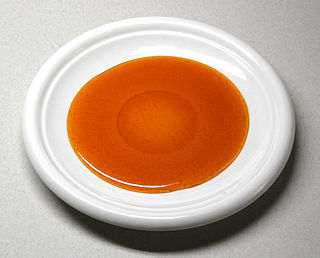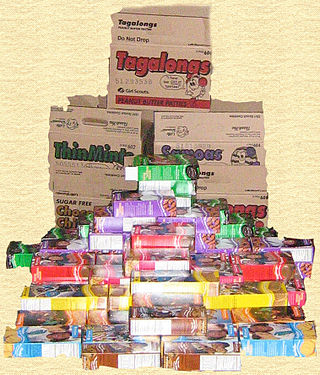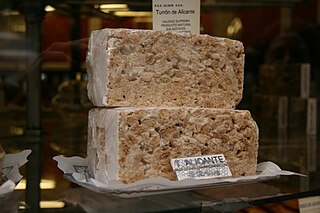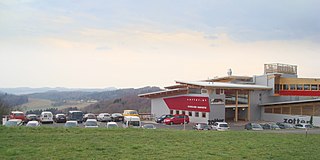Praline can refer to
- Praline (nut confection), a caramelised sugar heated to 160°C and combined with a roasted nut combination. Commonly made with sugar, corn syrup, milk, butter, and nut halves.
- Chocolate praline, chocolates with a soft filling.
Praline can refer to

Caramel is an orange-brown confectionery product made by heating a range of sugars. It can be used as a flavoring in puddings and desserts, as a filling in bonbons or candy bars, or as a topping for ice cream and custard.

A chocolate chip cookie is a drop cookie that features chocolate chips or chocolate morsels as its distinguishing ingredient. Chocolate chip cookies are claimed to have originated in the United States in 1938, when Ruth Graves Wakefield chopped up a Nestlé semi-sweet chocolate bar and added the chopped chocolate to a cookie recipe; however, historical recipes for grated or chopped chocolate cookies exist prior to 1938 by various other authors.

A chocolate bar is a confection containing chocolate, which may also contain layerings or mixtures that include nuts, fruit, caramel, nougat, and wafers. A flat, easily breakable, chocolate bar is also called a tablet. In some varieties of English and food labeling standards, the term chocolate bar is reserved for bars of solid chocolate, with candy bar used for products with additional ingredients.

Pralines are confections containing nuts – usually almonds, pecans and hazelnuts – and sugar. Cream is a common third ingredient.

Girl Scout Cookies are cookies sold by Girl Scouts in the United States to raise funds to support Girl Scout councils and individual troops. The cookies are widely popular and are commonly sold by going door-to-door, online, through school or town fundraisers, or at "cookie booths" set up at storefronts. The program is intended to both raise money and improve the financial literacy of girls. During an average selling season, more than one million girls sell over 200 million packages of cookies and raise over $800 million. The first known sale of cookies by Girl Scouts was in 1917. Cookie sales are organized by 112 regional Girl Scout councils who select one of two national bakeries to buy cookies from.

Turrón and torrone is a southwest European nougat confection, typically made of honey, sugar, and egg white, with toasted almonds or other nuts, and usually shaped either into a rectangular tablet or a round cake. Turrón is usually eaten as a dessert food around Christmas in Spain and Italy. It's also known in Portugal and the countries of Latin America.

Fudge is a type of confection that is made by mixing sugar, butter and milk. It has its origins in the 19th century United States, and was popular in the women's colleges of the time. Fudge can come in a variety of flavorings depending on the region or country it was made; popular flavors include fruit, nut, chocolate and caramel. Fudge is often bought as a gift from a gift shop in tourist areas and attractions.

Cadbury Dairy Milk is a British brand of milk chocolate manufactured by Cadbury. It was introduced in the United Kingdom in June 1905 and now consists of a number of products. Every product in the Dairy Milk line is made with exclusively milk chocolate. In 1928, Cadbury's introduced the "glass and a half" slogan to accompany the Dairy Milk chocolate bar, to advertise the bar's higher milk content.

A bonbon is a small chocolate confection. They are usually filled with liqueur or other sweet alcoholic ingredients, and sold wrapped in coloured foil.

Sugar candy is any candy whose primary ingredient is sugar. The main types of sugar candies are hard candies, fondants, caramels, jellies, and nougats. In British English, this broad category of sugar candies is called sweets, and the name candy or sugar-candy is used only for hard candies that are nearly solid sugar.

A chocolatier is a person or company who makes confectioneries from chocolate. Chocolatiers are distinct from chocolate makers, who create chocolate from cacao beans and other ingredients. They are pastry chefs or confectioners who specialize in chocolate and making chocolate candies. Chocolatiers work artisanally with ready-made chocolate mass and are therefore distinct from industrial chocolate makers.

Quality Street is a line of tinned and boxed toffees, chocolates and sweets, first manufactured by Mackintosh's in Halifax, West Yorkshire, England, in 1936. It was named after J. M. Barrie's play Quality Street. Since 1988 they have been produced by Nestlé. Quality Street have long been a competitor to Cadbury Roses which were launched by Cadbury in 1938.

Almond paste is made from ground almonds or almond meal and sugar in equal quantities, with small amounts of cooking oil, beaten eggs, heavy cream or corn syrup added as a binder. It is similar to marzipan, but has a coarser texture. Almond paste is used as a filling in pastries, but it can also be found in chocolates. In commercially manufactured almond paste, ground apricot or peach kernels are sometimes added to keep the cost down.

Cadbury Roses are a selection of machine wrapped chocolates made by Cadbury. Introduced in the UK in 1938, they were thought to be named after the English packaging equipment company "Rose Brothers" based in Gainsborough, Lincolnshire, that manufactured and supplied the machines that wrapped the chocolates.

A chocolate truffle is a type of chocolate confectionery traditionally made with a chocolate ganache center and coated in cocoa powder, coconut, or chopped nuts. A chocolate truffle is handrolled into a spherical or ball shape. The name derives from the chocolate truffle's similarity in appearance to truffles, a French tuber fungus.

Guylian is a Belgian chocolate brand and manufacturer best known for its seashell shaped pralines. The company was founded in 1958 in Sint-Niklaas, Belgium by Guy Foubert and is now owned by the South Korean company Lotte Confectionery.

Belgian chocolate is chocolate produced in Belgium. A major industry since the 19th century, today it forms an important part of the nation's economy and culture.

Zotter Schokolade is an Austrian chocolate manufacturer specializing in organic and fairly traded bean-to-bar chocolate. The company was founded in 1999 by Josef Zotter and is based in Riegersburg, Styria. Zotter is mostly active in German-speaking Europe, with 90 percent of distribution outlets being located in Germany, Switzerland, and Austria. As one of Austria's most well-known trademarks, Zotter is considered a national high equity brand.
Da-Capo is a chocolate bar produced by the Finnish company Fazer since 1916. Da-Capo was Fazer's first chocolate bar.